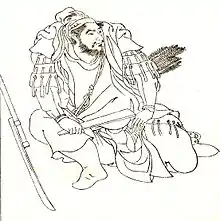
Ōtomo no Kanamura (大伴金村) was a Japanese warrior and statesman during the late Kofun period.[1] Most of what is known of his life comes from the Kojiki and the Nihon Shoki. His clan, the Ōtomo, had been highly influential at court since the time of his grandfather Ōtomo no Muroya.[2][3]
According to these sources, Kanamura was instrumental in putting down the uprising of Heguri no Matori (平群馬鳥) and in raising Emperor Buretsu to the throne.[1][4] Buretsu, in gratitude, raised Kanamura to the position of Ōmuraji (a high-ranking ministerial position).[5] He also oversaw the succession of Emperor Keitai, instead of the claimant Prince Yamatohiko, and selected Keitai's empress himself.[2][6][7] Kanamura embraced an aggressive policy towards the kingdom of Silla (part of modern-day Korea), and advocated sending forces there; his own son Ōtomo no Satehiko led two expeditions against the Korean kingdoms.[8] This policy eventually led to his downfall, when in 540 the Emperor Kinmei, under advice from the minister Mononobe no Okoshi, decided to refrain from direct military action against Silla. The Emperor also removed Kanamura from his position as Ōmuraji as a result.[3][9]
References
- 1 2 Louis Frédéric (2002). Japan Encyclopedia. Harvard University Press. p. 764. ISBN 978-0-674-01753-5.
- 1 2 Paula Doe; Yakamochi Ōtomo (January 1982). A Warbler's Song in the Dusk: The Life and Work of Ōtomo Yakamochi (718-785). University of California Press. pp. 6–7. ISBN 978-0-520-04346-6.
- 1 2 Kodansha Encyclopedia of Japan: Niju-Saka. Kodansha. 1983. pp. 130–131. ISBN 978-0-87011-626-1.
- ↑ Sir George Bailey Sansom (1978). Japan: A Short Cultural History. Stanford University Press. pp. 75. ISBN 978-0-8047-0954-5.
- ↑ Jien (1 January 1979). The Future and the Past: A Translation and Study of the Gukanshō, an Interpretative History of Japan Written in 1219. University of California Press. p. 260. ISBN 978-0-520-03460-0.
- ↑ Yoko Williams (11 October 2013). Tsumi - Offence and Retribution in Early Japan. Routledge. p. 228. ISBN 978-1-136-87422-2.
- ↑ Sir George Bailey Sansom (1958). A History of Japan to 1334. Stanford University Press. pp. 44. ISBN 978-0-8047-0523-3.
- ↑ Robert Karl Reischauer; Jean Reischauer; Woodrow Wilson School of Public and International Affairs (1967). Early Japanese history, c. 40 B.C.-A.D. 1167. P. Smith. p. 133.
- ↑ John Whitney Hall (30 July 1993). The Cambridge History of Japan. Cambridge University Press. p. 155. ISBN 978-0-521-22352-2.